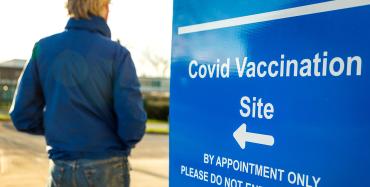Faculty and staff are on campus—maintaining HVAC systems and cleaning buildings; updating student records; conducting hybrid in-person and online classes; helping students with financial aid forms; and teaching hands-on classes like science labs, art studio sessions and physical education. They are doing all of this in person, with students and colleagues. Yet on some campuses, they do not have access to the COVID-19 vaccine.
“Illinois has thousands of higher education employees who are working face to face with students during the pandemic, including many educators, advisers, clerical staff, food service workers, security personnel, graduate workers and others,” says John Miller, president of University Professionals of Illinois, the union representing faculty and staff at seven of the state’s public universities. Yet Illinois has not included these workers in its current vaccine rollout.
Thousands have signed the Illinois Federation of Teachers’ petition urging Illinois Gov. J.B. Pritzker to prioritize higher education personnel for vaccination. While supporters enthusiastically applaud prioritizing preK-12 educators for vaccination—they are included in the current category for vaccination, Phase 1B—they want college and university staff to be protected as well. As the shortage of vaccines forces officials to mete out doses phase by phase, Illinois’ Phase 1B currently includes people over age 65 and frontline workers such as grocery store staff and teachers. Medical personnel and patients, and residents at long-term care facilities, were vaccinated during Phase 1A.
“By excluding the educators and staff who work in face-to-face environments in our colleges and universities, Illinois is endangering the safety of students and communities,” says IFT President Daniel Montgomery, an AFT vice president, who notes that science flags vaccinating essential education workers as a key component of safely reopening schools and academic institutions. “These essential workers—just like teachers and staff in our K-12 schools—should absolutely be included in Phase 1B for the COVID-19 vaccine.”
While they wait for policy to change, faculty and staff are lecturing through double layers of masks—despite the muffled sound effect—keeping their distance from students and praying they will not pass on the virus to family at home, or to colleagues and students on campus.
“I don’t want to go back to work and realize that some of those people who I used to talk to are now dead,” says Elizabeth Villarreal, an academic adviser at Northeastern Illinois University who was quoted in an article by Chicago’s local WTTW news. “Having access to the vaccine is what we’re talking about. For those that really need it, please include them in that 1B, because they have to go into these buildings. They have to go day to day.”
The Centers for Disease Control and Prevention defines higher education employees and faculty as essential employees, and many states have already included them in the same vaccination group as preK-12 educators and staff. In New York state, United University Professions, the faculty-staff union for the State University of New York, played a key role in winning prioritization for staff in March.
“For months, UUP worked closely with SUNY Chancellor Jim Malatras, state legislators and our union colleagues to extend priority vaccinations to include not only in-class faculty and instructors, but all on-campus employees who work with students and the public,” says UUP President Frederick Kowal, an AFT vice president. Those essential employees include residential life directors, counselors, instructional support staff, librarians, financial aid staff, researchers and other similar positions. Nearly 4,000 people signed a petition to clear SUNY employees for priority vaccines. “UUP will always do all it can to protect our members and ensure their safety on the job,” says Kowal.
In Illinois, UPI is also fighting hard to get its members what they need to do their jobs safely. The state’s Phase 1B began in February and is expected to continue through March; higher education employees there hope to be added to that phase rather than waiting indefinitely for Phase 1C.
[Virginia Myers]

